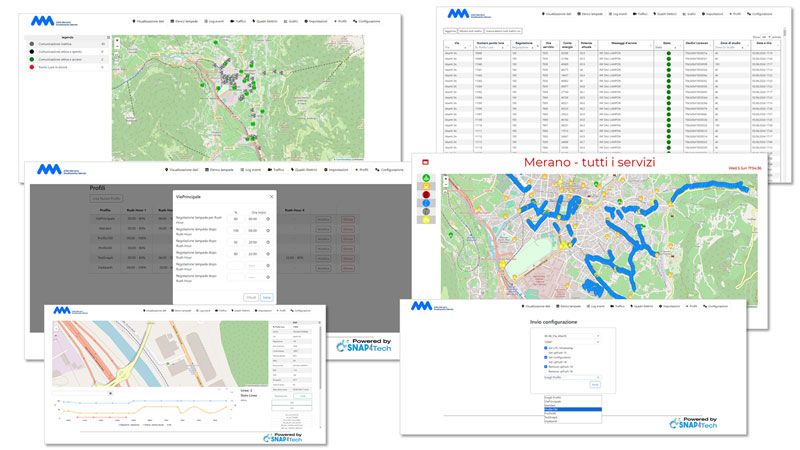by Nicola Mitolo (SNAP4 S.R.L.), Stefan Mutschlechner (ASM Merano), and Paolo Nesi (DISIT Lab, DINFO Dept, Univ. of Florence)
This article explores how the Merano Municipal Services Company (ASM Merano), with the support of SNAP4, is leveraging the Snap4City platform to revolutionise public lighting management. By implementing smart, adaptive lighting systems based on real-time traffic conditions, they aim to enhance energy efficiency, improve road safety, and accelerate the city's transition to a sustainable future. Discover how this innovative approach is setting new standards for smart city operations and sustainability.
The main challenges cities are facing today relate to the management of services and infrastructure in areas such as mobility and transportation, energy, governance, welfare, tourism, culture, environment, weather, and education. These areas influence each other, and under critical conditions, a domino effect becomes inevitable, causing additional problems and loss of control. Transforming a city into a smart city is a complex process that requires expertise, technological innovation, willingness to change, and collaboration among various stakeholders.
Municipalities must create sustainable solutions to optimise energy consumption, with public lighting being a critical factor in achieving these objectives and enhancing sustainability in line with the Sustainable Development Goals (SDGs). Efficient public lighting management includes designing algorithms and systems that adjust the intensity and timing of the lights based on actual needs, thereby reducing energy consumption. Additionally, adopting renewable energy sources to power these systems contributes to the promotion of green energy in urban areas. These interventions not only optimise energy usage but also support a sustainable energy transition, reducing environmental impact and improving the overall energy efficiency of cities.
The Snap4City open-source solution for smart light management is innovative, economically sustainable and technologically reliable. Public administrations can easily access and use the solution, adopting open technology to avoid vendor lock-in and proprietary technologies.
To this end, the Merano Municipal Services Company (ASM Merano), with the support of SNAP4 [L1], utilised the Snap4City platform [1], [L2] to implement a smart light management system for monitoring and controlling public lighting, encompassing thousands of luminaires [L3]. The solution is deployed on a public cloud, leveraging Merano's existing LoRaWAN network and connecting DALI 2 nodes, FlashNet, among others, which communicate through LoRaWAN gateways linked to an open-source network server based on the ChirpStack open-source solution. Snap4City is used for programming and managing dimming profiles (unicast and multicast), monitoring status and managing errors, and includes the monitoring of cabinets powering the luminaires and data from traffic sensors in different critical cross roads. The smart light management system incorporates adaptive lighting based on traffic conditions, known as Traffic Adaptive Installation (TAI). This system uses sensors and data analytics to monitor the flow of vehicles in the monitored areas. When traffic volume is high, the lighting intensity increases to ensure safety and visibility. Conversely, during periods of low traffic, the lighting intensity is reduced to save energy.
TAI represents one of the latest innovations in sustainable public smart light management. It enables automatic adjustment of street lighting based on traffic conditions. Utilising traffic monitoring data from various measurement points, Snap4City facilitates remote management of TAI in a simple and flexible manner, adhering to the standards defined in UNI11248:2016 [L3]. This is achieved by sending the necessary lighting regulation commands to the affected luminaires in multicast mode. This integrated technology offers numerous benefits for both administrations and citizens, including energy savings and improved road safety.
Using the Snap4City solution, several dashboards have been created, enabling operators to monitor and manage all the luminaires, network areas, and service quality. Snap4City dashboards simplify the service management modalities including dimming profiles and TAI modalities for the different zones in the areas.
In particular, the dashboards (see Figure 1) are providing:
- The map of the whole city area involved with custom dynamic pins geographically positioned in the map and representing the luminaries, cabinets, gateways and traffic sensors, changing their status in real time according to the data received. This allows providing stakeholders an immediate overview of the status of the implemented infrastructure, and identifying anomalies and dysfunctions.
- Real-time trend of the ingested data allows monitoring of the streetlights and cabinets data over time.
- The user interface to add new nodes in the multicast group, manage and set the different configuration and dimming profiles of all nodes connected in the network, by managing in the backend all the process logic to decode/code the proprietary protocol messages and commands.
- Program and manage the TAI enabling an integrated and sustainable smart adaptive lighting solution. The dashboard provides an interface for programming the time-controlled variations of luminance level in relation to hourly traffic flow, weather conditions or other parameters.

Figure 1: The Snap4City dashboards.
The solution implemented with Snap4City demonstrated the potential of an integrated approach for managing smart city operations more flexibly. This helps the municipality and stakeholders make better decisions. Merano and SNAP4 provided a practical solution for optimising energy consumption and usage, accelerating the city's smart city development and better addressing future sustainable energy transitions.
Links:
[L1] https://www.snap4.eu
[L2] https://www.snap4city.org
[L2] https://www.snap4.eu/products/smart-lights.html
[L3] https://store.uni.com/uni-11248-2016
Reference:
[1] C. Garau, et al, “A big data platform for smart and sustainable cities: environmental monitoring case studies in Europe,” in Proc. of Int. Conf. on Computational Science and its Applications, ICCSA2020. Cagliari, Italy, 1–4 July 2020. https://link.springer.com/chapter/10.1007%2F978-3-030-58820-5_30
Please contact:
Nicola Mitolo, SNAP4 S.R.L., Italy











